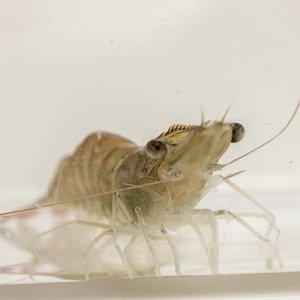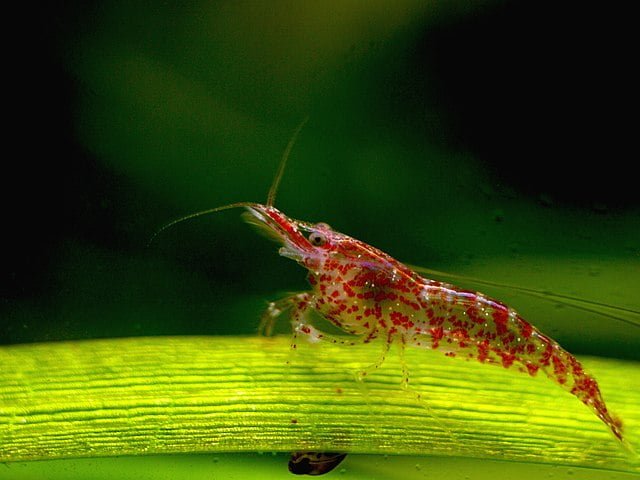
Chitin, the second most abundant polysaccharide in nature after cellulose, has emerged as a promising additive in aquaculture feed, with potential to improve growth, intestinal health, and immune response of aquatic organisms.
A team of researchers from the University of Udine published a scientific review on the effects of chitin in aquaculture feeds on growth, nutrient utilization, intestinal microbiome modulation, and immune system of aquatic organisms.
What is chitin and where is it found?
- 1 What is chitin and where is it found?
- 2 Sources of chitin for aquaculture feed
- 3 Effects of chitin on growth performance and nutrient utilization
- 4 Chitin and intestinal microbiota
- 5 Chitin and immune response
- 6 Impact on the aquaculture industry
- 7 Challenges and future perspectives
- 8 Conclusion
- 9 Entradas relacionadas:
Chitin is a versatile biopolymer composed of N-acetylglucosamine (NAG) and glucosamine units. It is mainly found in crustacean exoskeletons (crabs, shrimp), insects, fungal cell walls, mollusks, and some marine algae.
In recent years, interest in chitin has increased due to its various applications in medicine (surgical sutures, bandages), food packaging (antibacterial activity), and as an antioxidant.
Sources of chitin for aquaculture feed
Traditionally, shrimp meal and yeast meal have been the main sources of chitin in aquaculture feeds. However, the growing interest in insect meal as an ingredient for fish feed has made insects an important source of chitin.
Insects, especially in the pre-pupal stage, are rich in proteins, lipids, and minerals, and have a low environmental impact. Additionally, chitin remains from insect molts have become a valuable by-product with nutraceutical properties.
Effects of chitin on growth performance and nutrient utilization
According to the study published in Aquaculture International, the effects of chitin on growth performance of fish and crustaceans vary by species and dose.
Fish
Some species, such as cobia, Seriola, cod, Japanese eel, red sea bream, and European sea bass, have high chitinase activity and can efficiently digest chitin. However, other species, such as meagre, Atlantic salmon, and turbot, have limited capacity to digest chitin.
Stay Always Informed
Join our communities to instantly receive the most important news, reports, and analysis from the aquaculture industry.
In the case of rainbow trout, results are contradictory, which may be due to differences in fish size and experimental diet composition. In general, high concentrations of chitin in the diet can negatively affect fish growth.
Crustaceans
Crustaceans, whose natural diet contains chitin-containing organisms, are usually able to digest and utilize chitin efficiently. Studies have shown that dietary chitin inclusion does not negatively affect zootechnical performance in white shrimp and prawns.
Chitin and intestinal microbiota
The study reports that chitin can modulate fish intestinal microbiota, which may have beneficial health effects.
Chitin acts as a prebiotic, promoting the growth of beneficial bacteria such as Bifidobacterium and Lactobacillus. These bacteria can produce short-chain fatty acids (SCFAs), such as butyrate, which strengthen the intestinal epithelial barrier and have antimicrobial properties.
Chitin can also inhibit the growth of pathogenic microorganisms such as Salmonella typhimurium and Escherichia coli.
In Atlantic salmon, chitin can increase the abundance of bacteria such as Bacillus, Enterococcus, and Actinomyces.
Chitin and immune response
- Chitin can act as a natural immunostimulant, improving the immune response of fish and crustaceans.
- Chitin can be recognized by the immune system as a pathogen-associated molecular pattern (PAMP), triggering an immune response.
- Oral administration of chitin can increase superoxide anion production and lysozyme activity in fish.
- Chitin can also improve phagocytic activity and resistance to infections in fish and crustaceans.
- In crustaceans, chitin can increase total antioxidant status and activity of enzymes such as superoxide dismutase (SOD) and glutathione peroxidase (GSH-Px), reducing oxidative stress.
- Chitin can have a synergistic effect with probiotics, further enhancing immune function.
Impact on the aquaculture industry
According to sources, chitin offers several benefits for the aquaculture industry:
- Growth improvement in certain species: In crustaceans, dietary chitin inclusion does not harm zootechnical performance and may even improve growth. In fish, the effect varies by species.
- Promotion of intestinal health: Chitin acts as a prebiotic, favoring the growth of beneficial bacteria in fish intestines.
- Immune response stimulation: Chitin can act as a natural immunostimulant, improving immune response in both fish and crustaceans.
- Sustainability potential: The use of chitin-rich by-products from insect and crustacean production represents an opportunity to promote sustainability and circular economy in aquaculture. Valorization of these residues can reduce waste and provide a sustainable source of chitin.
Challenges and future perspectives
Despite the potential benefits of chitin in aquaculture, several challenges need to be addressed:
- Variability in results: Chitin effects vary by species, dose, source, and processing method. Optimization of chitin levels is necessary for each specific species and situation.
- Quantification methods: Precise quantification of chitin in feeds and aquatic organisms remains a challenge. More accurate and standardized analysis methods are needed.
- Research in crustaceans: Although numerous studies have been conducted on chitin effects in fish, more research is needed on its effects on crustacean intestinal microbiota.
In the future, the utilization of chitin-rich by-products from insect and crustacean production industries could provide a sustainable source of chitin for aquaculture, promoting circular economy and reducing waste.
Conclusion
Chitin is a promising additive for aquaculture feeds, with potential to improve growth, intestinal health, and immune response of aquatic organisms. However, further research is needed to better understand chitin effects and optimize its utilization in aquaculture feed.
By addressing current challenges and exploring new chitin sources, we can maximize the potential of this biopolymer to promote more sustainable and efficient aquaculture.
Contact
Francesca Tulli
Department of Agriculture, Food, Environment and Animal Science, University of Udine
Udine, Italy
Email: francesca.tulli@uniud.it
Reference (open access)
Pascon, G., Akinyi, R. O., Cardinaletti, G., Daniso, E., Messina, M., & Tulli, F. (2025). Chitin and its effects when included in aquafeed. Aquaculture International, 33, 202–224. https://doi.org/10.1007/s10499-025-01879-z
Editor at the digital magazine AquaHoy. He holds a degree in Aquaculture Biology from the National University of Santa (UNS) and a Master’s degree in Science and Innovation Management from the Polytechnic University of Valencia, with postgraduate diplomas in Business Innovation and Innovation Management. He possesses extensive experience in the aquaculture and fisheries sector, having led the Fisheries Innovation Unit of the National Program for Innovation in Fisheries and Aquaculture (PNIPA). He has served as a senior consultant in technology watch, an innovation project formulator and advisor, and a lecturer at UNS. He is a member of the Peruvian College of Biologists and was recognized by the World Aquaculture Society (WAS) in 2016 for his contribution to aquaculture.




